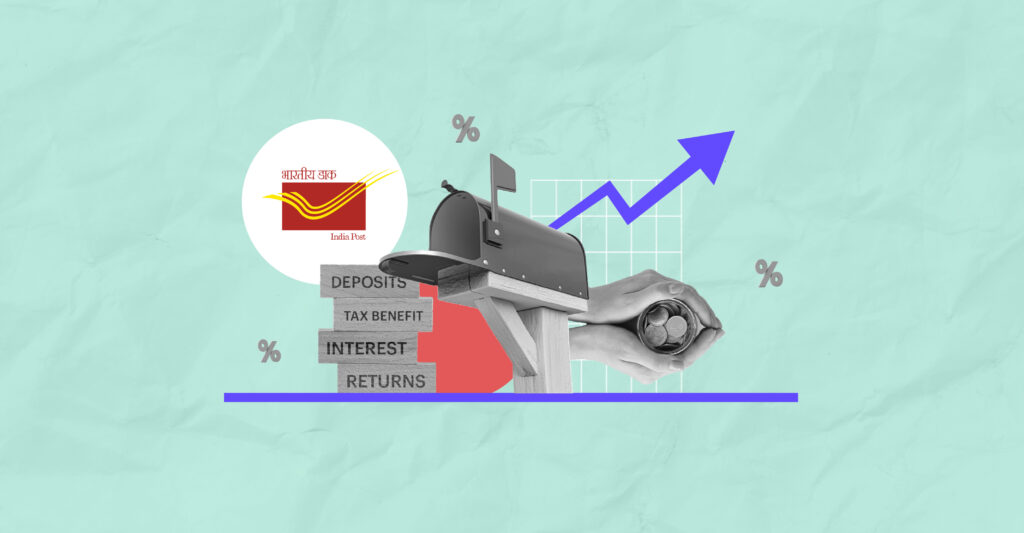Last Updated on Jul 27, 2022 by Aradhana Gotur
With ~1.5 lakh offices across the country, India Post is the most widely distributed post network in the world. Apart from postal services, India Post also offers certain financial services, including savings schemes. One such savings scheme is the Post Office Time Deposit. Owing to India Post’s vast network, Post Office Time Deposit is mainly famous in rural areas whose residents are underserved by banks.
Table of Contents
What is a Post Office Time Deposit (POTD)?
A POTD shares many similarities with bank fixed deposits. The principal amount deposited in a Post Office Time Deposit scheme earns interest throughout the predetermined tenure. On maturity, you get access to the principal amount plus interest thereon.
Types of Post Office Time Deposit accounts
There are four types of POTD accounts. Depending on the tenure of the account, an investment in Post Office Time Deposit is locked in for 1 yr, 2 yr, 3 yr or 5 yr.
Features and benefits of Post Office Time Deposit
- Joint account: Individuals are allowed to open joint accounts. At maximum, three persons can hold one account together
- Transferability: You are allowed to transfer a Post Office Time Deposit account across post offices in the country
- Minor: Individuals aged 10 yrs and above can also open and manage a POTD account
- Lock-in periods and extension of maturity: As discussed, POTD offers accounts with four lock-in periods – 1 yr, 2 yr, 3 yr, and 4 yr. You can extend these maturity periods by applying to the concerned post office
- Tax benefits: Only the 5-yr Post Office Time Deposit scheme comes with tax benefits. You can claim a deduction of up to Rs. 1.5 lakh under Section 80C for this variant
- Interest rates: Post Office Time Deposit interest rate is more or less in line with that of a Fixed Deposit (FD). A table on POTD interest rates is given below. The returns are stable and assured as the scheme is backed by the government
- Interest post maturity: You can continue your deposit after maturity, but it ceases to earn additional interest. However, accounts with post offices having core banking solutions get renewed for the initial maturity period. The account earns returns at the Post Office Time Deposit scheme interest rate prevailing at the time of renewal
- Minimum and maximum deposit amount: A time deposit in a post office has flexible investment options. The minimum deposit accepted by a Post Office TD is as low as Rs. 200, while there is no limit on the maximum amount.
- Mode of deposit: You can deposit cash or cheque. In the case of a cheque deposit, the date of encashment is considered the account opening date
- Premature withdrawal: You can only withdraw your investment in a Post Office Time Deposit after the completion of 6 months from the account opening date. In case of withdrawals before 6 months, the interest rate will be reduced to that of a savings account, which is 4% p.a.
- No. of accounts: There is no restriction on the number of POTD accounts an individual can open
- Nomination facility: You are allowed to add nominees to your accounts
Post Office Time Deposit interest rate
The interest rate on POTD is reviewed by the Finance Ministry every quarter of the financial year. The interest rate is ascertained based on the yield on government securities of similar maturities with a spread of 0.25%.
Following is the table of interest rates for POTD accounts with varying tenures. These are applicable from 1st July 2022 to 30th September 2022.
| Account tenure | Interest rate |
| 1 yr | 5.5% |
| 2 yrs | 5.5% |
| 3 yrs | 5.5% |
| 5 yrs | 6.7% |
Post Office Time Deposit interest payout
Interest on POTD is compounded quarterly but paid annually. In case you do not want to withdraw interest every year, you can request the post office to transfer it to your savings account in the same post office. This facility is not available for 1-yr POTD.
Alternatively, you can instruct the interest to be redirected to a 5-yr recurring deposit in the same post office or bank in lieu of 12 monthly instalments. In this case, you must submit an application to the post office or bank before the interest payment due date.
Note that the savings account has to be in the same post office. Further, this facility is only available at Head or Departmental Sub Offices, not sub-offices and branch offices.
Eligibility criteria for Post Office TD
- Indian residents are allowed to open and operate this account either individually or jointly
- A minor aged 10 yrs or above is allowed to open and operate POTD
- Parents/Guardians can open a Post Office Time Deposit account on behalf of a minor
- Non-resident Indians, institutional account holders, trust funds, regimental funds, and welfare funds cannot open a Post Office TD account
How to open a Post Office Time Deposit?
Get the application form
Visit the nearest post office and request the Post Office Time Deposit application form. Alternatively, you can download the Post Office Time Deposit Account Opening Form online.
Fill the form
Fill out the Post Office Time Deposit Account Opening Form with the correct details. You will require the following information:
-Applicant’s name
-Residential address
-Applicant’s date of birth
-Details of your first deposit
-Know Your Customer (KYC) details
-Aadhaar card number
-Nomination details
Submit the form
Once you fill out the form, submit it to the post office along with the required documents. Make sure to carry the original documents for in-person KYC verification.
Documents required for Post Office Time Deposit scheme
- SB3
- SB13 (pay-in slip)
- Specimen Signature Slip
Taxation benefits of Post Office Time Deposit scheme
Deposits made in a 5-yr POTD are eligible for tax benefits under Section 80C of the Income Tax Act. Interest earned is added to the total annual income in the year of receipt and is taxed as per the applicable tax rate. No TDS is applicable on POTD.
Premature withdrawal of Post Office TD
You can withdraw funds from your Post Office Time Deposit account only after 6 months from the date of the first deposit. Note the following terms and conditions of premature withdrawal:
- In case of withdrawals made after the completion of 6 months but before 1 yr from the date of account opening, simple interest is calculated based on the Post Office Savings Account interest rate
- In case of withdrawals made after 1 yr from the account opening date, returns are calculated at 1% lower than the predetermined Post Office Time Deposit interest rate corresponding to the tenure
Who should invest in POTD?
- If you are looking for alternatives to bank fixed deposits
- If you are a conservative investor who doesn’t want to take risks
POTD vs bank FD
Although both the schemes are similar, they have certain differences, as discussed in the table below.
| Particulars | Post Office Time Deposit | Fixed Deposit |
| Additional interest for senior citizens | Not given | Given |
| Interest payment frequency | Annual | Monthly, quarterly, annually |
| Lock-in period | 1-5 yrs | 7 days – 10 yrs |
| Extension | -Prior application -Available only at post offices with core banking facilities | Yes |
| Premature withdrawal | Permitted only after 6 months from the opening date | Depends on the bank/NBFC |
| Loan against the deposit | Not available | Depends on the bank/NBFC |
| TDS | Not applicable | Applicable |
Post Office Time Deposit FAQs
What is a time deposit in the post office?
Post office time deposit is a savings scheme offered by India Post. Like an FD, you invest the principal amount for a predetermined period and earn interest thereon. You will receive the maturity proceeds—principal + interest—at the end of the tenure.
What is the minimum investment for a POTD?
You can open a Post Office Time Deposit account with as low as Rs. 200. There is no limit on the maximum amount.
Can I avail tax benefits on POTD?
Only account holders of a 5-yr Post Office Time Deposit can avail a tax deduction under Section 80C.
Is TDS applicable on Post Office Time Deposit?
No. TDS is not applicable on POTD.
Is interest on Post Office Time Deposit taxable?
Interest earned on this scheme is added to the total annual income of an account holder and taxed at the applicable slab rate.
Can I transfer Post Office Time Deposit from one post office to another?
Yes. You can submit a manual application to the post office or the SB10(b) Form.
Is premature closure of POTD allowed?
Yes. But you can only close your POTD account after the completion of 6 months from the opening date. Read above for the applicable terms and conditions.
Can I open a Post Office Time Deposit account online?
You can only download the account opening form online. After filling it out, you must submit the form at the nearest post office branch.




